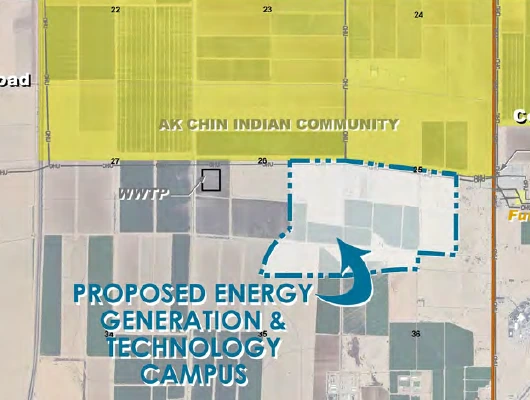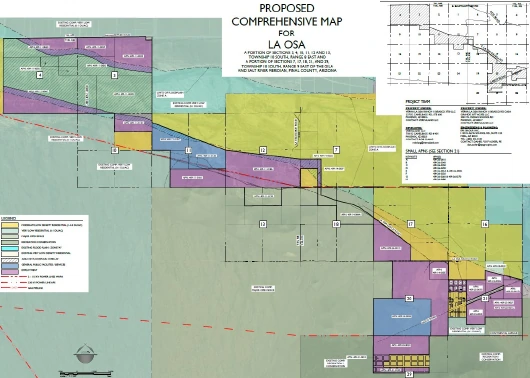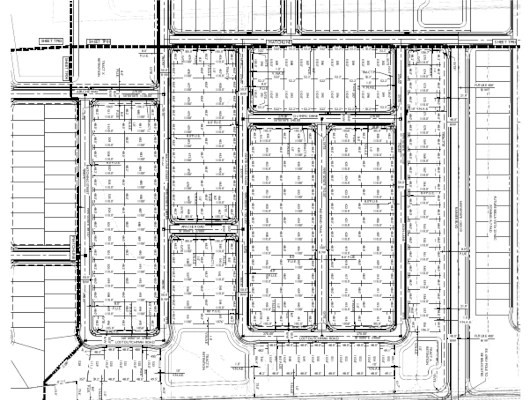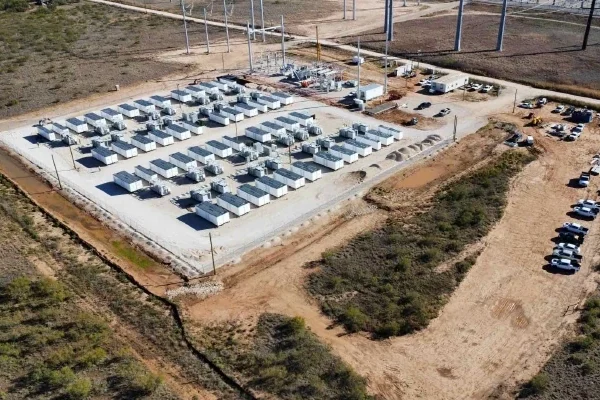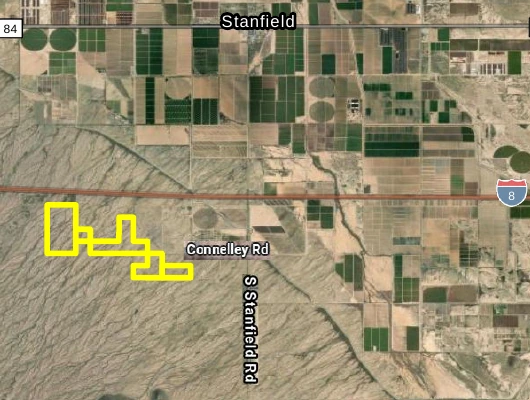The Pinal County Board of Supervisors approved a major land use change for a 495-acre energy and technology campus on November 19, 2025. The project includes data centers, a natural gas power plant, and battery storage. The vote passed after testimony from supporters and opponents, including representatives from the Ak-Chin Indian Community.
The energy generation and technology campus sits three miles south of the City of Maricopa. It borders the Ak-Chin Indian Community on its northern edge. The Nissan Technical Center sits just to the east. The land is currently zoned for homes but used for farming.

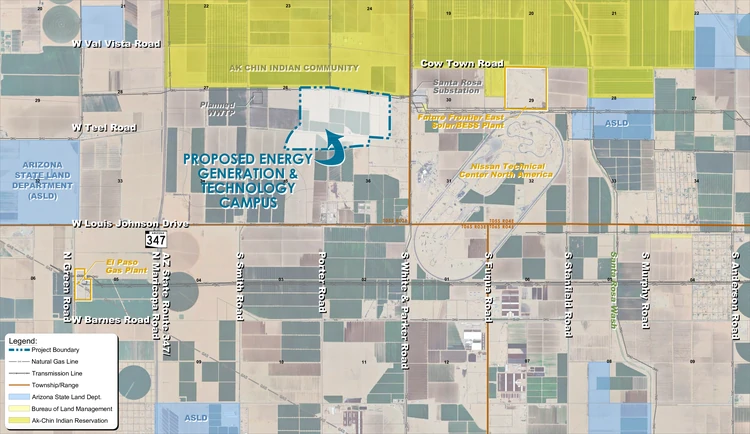
What the Project Includes
The campus will feature data centers, a natural gas power plant, and battery storage systems. Developer Copia Power, backed by investment firm Carlyle, has 450 megawatts already operating in Arizona with another 1,050 megawatts under construction.
Court Rich of Rose Law Group represented the applicant. When asked about the building design, Rich said the idea is that it “looks like an office building” or “an office park type of structure” with landscaping. When Supervisor Rich Vitiello asked about building height, Rich said specific designs would come during the rezoning phase.
The project connects to the Griffin Energy Project southeast of Stanfield. That solar, gas, and battery facility will help power the data center campus.
Water and Cooling System
The applicant said the campus will use a closed-loop, air-cooled system instead of water for cooling. Rich said they will commit to this at the rezoning stage. This design eliminates the need for water evaporation towers common in older data centers.
The applicant compared annual water use across different land uses:
- Data center campus: 500 acre-feet
- Approved housing: 931 acre-feet
- Farming: 1,980 acre-feet
The data center uses 75 percent less water than farming and 47 percent less than housing.
Jobs and Economic Impact
An Elliott Pollack & Company study provided detailed economic projections.
Investment:
- Construction costs: $4 billion
- Equipment: $5.5 billion
Jobs:
- Direct permanent jobs: 500
- Indirect and induced jobs: 588
- Total permanent jobs: over 1,000
Annual revenue and wages:
- Wages to employees: $66.2 million
- Total tax revenue: $44 million
- County tax revenue: $9 million
- Sales tax: over $20 million
- School funding: $6 million
Construction phase:
- Construction wages: nearly $500 million
Over 25 years, it was estimated that schools would receive $125 million.
Rich highlighted the job impact. “If this project were in place today, or at the time that this study was done, in the City of Maricopa, it would be the third-largest employer in the city with just the direct jobs at that location,” he said.
Supervisor Vitiello asked why this project shows 500 jobs when other data centers claim only 100 to 200. Rich explained the estimate assumes 100 to 140 jobs per building. Vitiello calculated that would mean about five buildings, and Rich agreed.
Housing and Traffic Effects
The land currently has approval for 1,945 single-family homes. The data center would replace those planned homes.
Rich argued this benefits traffic. The project would generate 80 percent fewer daily vehicle trips than the approved housing. The data center expects 3,791 daily trips compared to 18,322 for housing.
Traffic flow also helps State Route 347. Workers heading south to the campus in the morning would travel opposite the rush-hour traffic flowing north. Evening commutes would reverse this pattern. Rich said this means 500 fewer trips heading north during rush hour.
City of Maricopa Changes Position
The City of Maricopa initially opposed the project. A letter from August 2025 cited concerns about lost housing stock and conformance with the city’s general plan.
The city shifted to a neutral position in October. Planning Manager Rick Williams wrote that the applicant agreed to design the site to meet city development standards. The applicant is also working toward a pre-annexation agreement.
Robin Davis, a Hidden Valley resident, questioned this change during public comment. “At the last minute, the City of Maricopa goes from opposition to neutral,” she said. “I hear they signed an agreement of pre-annexation to that area. That sounds like future tax revenue to me.”
Davis said she was “exhausted listening to the lawyers and everything that they have to say and the way they spin everything.” She raised concerns about losing farmland. “No farmers, no food,” she said. “We’re fighting for a way of life out there that’s being decided for us.”
Support and Opposition Summary
Panchenko reported “12 letters of opposition from the members of the public” and “nine letters of support.” The Ak-Chin Indian Community opposed the location in a letter signed by Chairman Gabriel Lopez.
Opposition letters cited water depletion, noise, pollution, and limited job opportunities. Support letters cited economic development, employment, and renewable energy.
Two neutral letters came from the City of Maricopa and the Air Force. The Citizens Advisory Committee voted 8-5 with one abstention against recommending approval. The Planning and Zoning Commission voted 6-2 to recommend approval.
Ak-Chin Community Raises Cultural Concerns
Delia Carlyle, vice-chairwoman of the Ak-Chin Indian Community, addressed the board. She made clear the tribe’s position on the location.
“We are not opposed to the project but however, we are definitely opposed to where the site is being considered for that,” Carlyle said.
The site borders the community’s southern boundary. Carlyle explained that the area contains known cultural artifacts and human remains. “What we’re worried about, concerned about, is there are sites out there that have been identified, and unfortunately, there are other sites that will be identified out in that area,” she said.
Carlyle described the tribe’s request. “We don’t ask other than being allowed to bring them back home and not have them bothered again,” Carlyle said. She noted that construction could uncover cremations even six feet underground.
Environmental and Safety Questions
Roman Gabriel Orona, Environmental Programs Manager for the Ak-Chin Indian Community, raised additional concerns.
“We do have air monitors in Ak-Chin. And if those are starting to go off, then what is that gonna look like as we move forward?” Orona said.
He also raised questions about coolant chemicals. “If we’re going to a closed-loop system, how are those coolants gonna be taken care of?” Orona said.
Orona noted chemicals and supplies traveling down State Route 347 alongside other traffic. He urged viewing this as part of a larger picture across the corridor.
Orona also raised wildlife concerns. Burrowing owl populations on Ak-Chin land have grown from a handful to a couple hundred. He said the tribe now has to manage wildlife coming onto the community.
Fire Chief Outlines Coverage Plan
Fire Chief Jeff Heaton spoke again about fire protection. Arizona City Fire District is forming the Pinal County Fire & Medical Authority. Heaton said the data center project allows the authority to build a fire station just west of the site. This would be the northernmost station the authority incorporates. It would serve both the project and surrounding residents, including those in the Papago Ranch area who currently have no fire protection.
Heaton explained the funding model. Developers pay upfront to build stations and buy equipment. They also fund initial staffing. Tax revenue then supports ongoing operations.
Heaton also described coordination with Ak-Chin fire services and the City of Maricopa.
Public Comments Split
Maryeileen Flanagan from Hidden Valley raised several concerns. She worried about power grid capacity. “The applicant said that some power from the grid might even be needed, so that really strikes a chord with me,” she said.
Flanagan asked about commercial development. The original residential plan included commercial space. She wondered if the data center would eliminate that. “We need something so we don’t have to drive 17 miles into Maricopa to shop, to go to restaurants,” she said.
Flanagan also raised dark sky concerns. “Will this data center be a dark sky data center? We’ve lost our dark sky out in Hidden Valley and we’d like to get it back,” she said.
Cepand Alizadeh from the Arizona Technology Council spoke in support. He described a Data Center Day at Mesa Community College that drew 450 students. These jobs offer attainable careers with health insurance, dental, and vision benefits.
“We cannot turn our noses up at jobs, especially the jobs that will bring people to Pinal County from other places and help them establish roots in this county and contribute to this county’s betterment,” Alizadeh said.
Alizadeh noted that data centers are defined in different ways. A hospital may have a small data center with one IT employee. This larger project will employ far more people.
Brian Yerges from Electrical District No. 3 confirmed the utility’s support. The project location sits near existing electrical infrastructure. “They’ve been a good partner, and I’d be happy to answer any questions you have specific to ED3,” Yerges said. “It is an official ED 3 project.”
Karen Mooney, a commissioner on Pinal County’s Planning and Zoning Commission, attended as a citizen. She said she was not for or against the project. However, she urged the county to look beyond its current requirements and consider how drainage changes affect properties farther from the development site. Her own property has been affected by flooding from upstream development. “I’m just asking that they maybe reach further beyond as to where this water does end up,” she said.
Supervisors Ask About Data Center Reach
Supervisor Jeff Serdy questioned how data centers work. He asked about saturation and whether one massive facility could serve the entire region.
“When is enough data centers enough?” Serdy asked. “Is there a super data center that can do them all?”
Rich explained that data stored in these centers can be accessed from anywhere on Earth. However, industry prefers nearby locations because even fractions of seconds affect transmission quality, especially when processing AI requests.
Vice-Chairman Jeff McClure added context. “There’s 471 of them in Maricopa County,” he said.
Chairman Stephen Miller noted that many large manufacturers build their own data centers. “Lucid Motors has a data center. They have built it right into their system,” Miller said.
Supervisors Vote to Approve
Supervisor Vitiello addressed the Ak-Chin concerns directly. He asked Rich to commit to ongoing communication with the tribe before construction begins. Rich confirmed the developer had surveyed the 495-acre site and found no cultural artifacts. However, he committed to having tribal representatives present during earth-moving work.
“I really wanna make sure that their input, especially for their artifacts and the owls or whatever it may be that they are concerned about, that they are going to be a big part of this before a building goes up,” Vitiello said.
Supervisor Mike Goodman spoke before the vote. He emphasized private property rights and landowner freedom. He noted a farmer currently on the land “is trying to maximize the most that he can out of what he has.”
“Growth and change is inevitable,” Goodman said. “If we’re not growing, we’re shrinking.”
Goodman moved to approve. Vitiello seconded. The motion passed unanimously.
What Happens Next
The approval allows the applicant to begin the rezoning process.
This article continues coverage from our previous report. For details on the Planning and Zoning Commission hearing, public testimony, and the Griffin Energy Project connection, see: Commission Recommends Data Center Campus Despite Resident, Tribal Pushback
